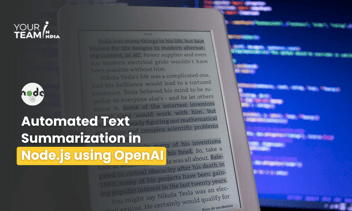This blog post delves into the exciting world of real-time language translation using Node.js and OpenAI. Discover how to leverage the power of OpenAI's language models to build applications that can instantly translate text between multiple languages, breaking down communication barriers and enhancing user experiences.
Introduction
In today's interconnected world, effective communication across language barriers is essential for businesses, organizations, and individuals. Real-time language translation has emerged as a powerful tool to bridge these gaps and foster global collaboration. Leveraging OpenAI's language models in Node.js, we can create applications that enable seamless communication across languages in a variety of scenarios. In this article, we'll explore how Node.js can be employed to build real-time language translation applications using OpenAI's technology.
Key Takeaways
- Learn how to seamlessly integrate OpenAI's language models into your Node.js applications, making translation a smooth and user-friendly experience.
- Real-time translation enhances user experiences by enabling multilingual communication, making your application more accessible and user-centric.
- By embracing AI-powered language translation, you stay ahead of the technological curve, ensuring your applications remain competitive in a rapidly evolving digital landscape.
The Power of OpenAI's Language Models
OpenAI has been at the forefront of natural language processing and understanding with models like GPT-3.5. These models are capable of understanding and generating human-like text, making them invaluable for language translation tasks. By integrating OpenAI's language models into our Node.js applications, we can achieve real-time translation that is both accurate and contextually relevant.
Setting Up Your Node.js Environment
Before diving into the development process, you'll need to set up your Node.js environment. Ensure you have Node.js installed on your system, and consider using a package manager like npm or yarn to manage your project's dependencies efficiently.
Integrating OpenAI's API
To get started with real-time language translation, you'll need access to OpenAI's API. Sign up for an API key on the OpenAI platform, and then install the `openai` package using npm or yarn:

Next, you'll need to authenticate your requests to the OpenAI API using your API key. You can do this by adding the following code to your Node.js application:

Implementing Real-Time Translation
With OpenAI integrated into your Node.js application, you can now implement real-time translation. Here's a basic example of translating text from English to French:

This code sends a request to OpenAI's API, specifying the source text and the target language. Upon receiving the response, it logs the translated text to the console.
Building Real-World Applications
Real-time language translation in Node.js opens up a world of possibilities for various applications. Some potential use cases include:
- Multilingual Chatbots: Create chatbots that can converse with users in multiple languages, providing support and information effortlessly.
- Language Learning Tools: Build language learning platforms that offer instant translation and pronunciation assistance to learners.
- Global Customer Support: Enable businesses to provide customer support in customers' preferred languages, improving user satisfaction.
- Content Localization: Automatically translate content on websites or apps to cater to a global audience.
Looking to build a Node.js application that can break down language barriers and connect with a global audience? Hire Node.js developers from Your Team in India, and let us take it forward.
Conclusion
Node.js, coupled with OpenAI's language models, empowers developers to create real-time language translation applications that break down language barriers. Whether you're looking to enhance customer support, facilitate cross-cultural communication, or build innovative language-related tools, Node.js and OpenAI are a powerful combination to consider. With the right implementation, you can harness the potential of real-time language translation to make the world a more connected place.









